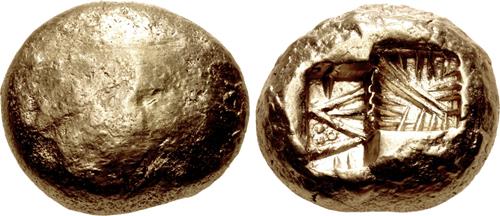|
IONIA, Uncertain. Circa 650-600 BC. EL Trite – Third Stater (12.5mm, 4.70 g). Lydo-Milesian standard. Plain globular surface; traces of letters of an uncertain script along part of edge / Two incuse rectangles with geometric patterns. Unpublished. As made. Extremely rare.
This coin is the first trite of a recently discovered inscribed electrum issue with an otherwise plain obverse, of which only a handful of hektai were previously known (cf. CNG 112, lots 263–4, and the following lot). The first of the hektai was noted in a private British collection in 2011, while the first appeared publicly, at auction, as lot 24985 in the Heritage 3020 sale in 2012, a piece that had been in an private collection in Europe. A third example appeared in 2017, as lot 30097 in Heritage 3054, and a fourth last year, as lot 101 in Savoca Online Auction 29.
The prior analysis of these coins has associated the issue with the ubiquitous plain obverse hektai of Ionia, suggesting that this inscribed version was perhaps a late issue in the production of that coinage, with struck dates suggested in the 660s and 640s BC. Admittedly, the form of this issue, and its metrology, do comport with the uninscribed plain incuse issues of that period. However, the peculiar reverse punch of this issue should not be overlooked. With regard to the complex varieties of early electrum, associations and relative chronologies are often established through reverse die linkages or similarities of idiosyncratic punch forms.
The rectangular punch used for this issue bears little resemblance to the two small punches used on the uninscribed plain hektai of the mid 7th century. The use of two small square punches, in fact, appears to have been a canonical aspect of not only the plain hektai, but also the ubiquitous striated electrum issues also dated to the 7th century, and even the contemporary royal Lydian hektai that circulated throughout the region. These small punches were also plain in appearance, devoid of any designs. These aspects suggest that the inscribed plain hektai are not closely associated to the uninscribed plain issues. Moreover, a small group of these inscribed coins was presented to a researcher, which was accompanied by a known Carian issue that dated to the early 5th century BC. The researcher noted the surfaces and fabric of the issues appeared highly consistent, suggesting they were part of a single hoard. This, in turn, suggested that these electrum coins were struck later than the 7th century, possibly as late as the end of the 6th century.
Turning to the inscription, elements of the letters appear similar to a number of glyphs in the various alphabets that were used along the coast of western Asia Minor. However, as a whole, the letters most closely resemble those found in the Carian alphabet (see Tables I and II in I.J. Adiego, The Carian Language [Brill: Leiden, 2007]), though the exact interpretation of legend remains uncertain.
The final winners of all Triton XXIII lots will be determined at the live public sale that will be held on 14-15 January 2020. Triton XXIII – Session Two – Greek Coinage Part II through Roman Imperial Coinage Part I will be held Tuesday afternoon, 14 January 2020 beginning at 2:00 PM ET.
Winning bids are subject to a 20% buyer's fee for bids placed on this website and in person at the public auction, 22.50% for all others.
|
